AMD Radeon HD 7870 GHz Edition & Radeon HD 7850 Review: Rounding Out Southern Islands
by Ryan Smith on March 5, 2012 12:01 AM ESTOverclocking: Power, Temp, & Noise
As with the rest of Southern Islands, AMD is making sure to promote the overclockability of their cards. And why not? So far we’ve seen every 7700 and 7900 card overclock by at least 12% on stock voltage, indicating there’s a surprising amount of headroom in these cards. The fact that performance has been scaling so well with overclocking only makes overclocking even more enticing. Who doesn’t want free performance?
So how does Pircairn and the 7800 series stack up compared to the 7700 and 7900 series when it comes to overclocking? Quite well actually; it easily lives up to the standards set by AMD’s previous Southern Islands cards.
| Radeon HD 7800 Series Overclocking | ||||
| AMD Radeon HD 7870 | AMD Radeon HD 7850 | |||
| Shipping Core Clock | 1000MHz | 860MHz | ||
| Shipping Memory Clock | 4.8GHz | 4.8GHz | ||
| Shipping Voltage | 1.219v | 1.213v | ||
| Overclock Core Clock | 1150MHz | 1050MHz | ||
| Overclock Memory Clock | 5.4GHz | 5.4GHz | ||
| Overclock Voltage | 1.219v | 1.213v | ||
Overall we were able to push our 7870 from 1000MHz to 1150MHz, representing a sizable 15% core overclock. This is now the 3rd SI card we’ve hit 1125MHz or 1150MHz – the other two being the 7970 and the 7770 – so AMD’s overclocking headroom has been extremely consistent for their upper tier cards.
As for memory overclocking, we hit 5.4GHz on both cards before general performance started to plateau, representing a 12.5% memory overclock. Considering that both cards use the same RAM on the same PCB, and the performance limitation is the memory bus itself, this is consistent with what we would have expected. With that said, we are a bit surprised that we got so far over 5GHz on 2Gb GDDR5 memory chips only rated for 5GHz in the first place; it indicates that Hynix’s GDDR5 production very mature.
With that said, because of the unique and non-retail nature of the 7850 AMD supplied us, the 7850 overclocking results should be considered low-confidence. The retail 7850 cards will be using simpler and no doubt cheaper coolers, PCBs, and VRMs; all of these can reduce the amount of overclocking headroom a card has. It’s by no means impossible that a 7850 could hit 1050MHz/5.4GHz, but it’s far more likely on a 7870 PCB than it is on a 7850 PCB.
Anyhow we’ll take a look at gaming performance in a moment, but in the meantime let’s take a look at what our overclocks do to power, temperature, and noise.
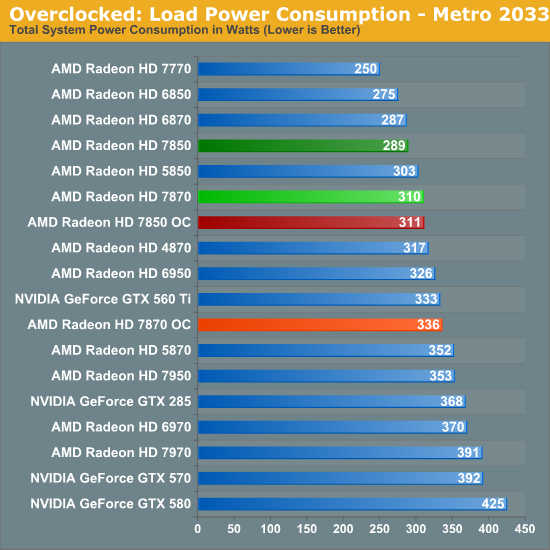
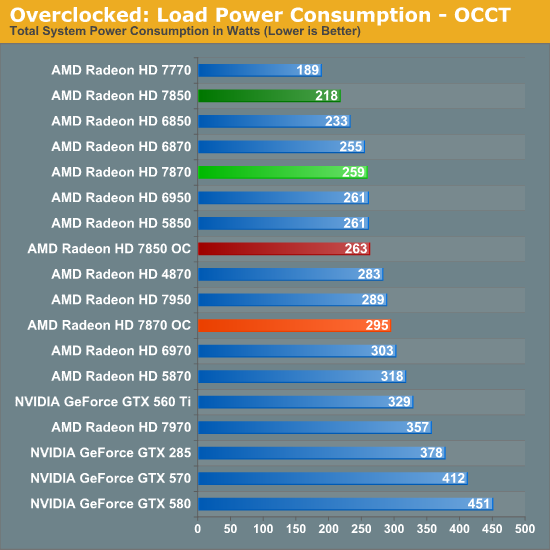
Even without a voltage increase overclocking does cause power consumption to go up, but not by a great deal. Under Metro the total difference is roughly 21W for the 7850 and 25W for the 7870, at least some of which can be traced back to the increased load on the CPU. Whereas on OCCT there’s a difference of nearly 40W on both cards, thanks to the increased PowerTune limits we’re using to avoid any kind of throttling when overclocked. All things considered with our overclocks power consumption for the 7850 approaches that of the 7870 and the 7870 approaches the GTX 560 Ti, which as we’ll see is a fairly small power consumption increase for the performance increase we’re getting.
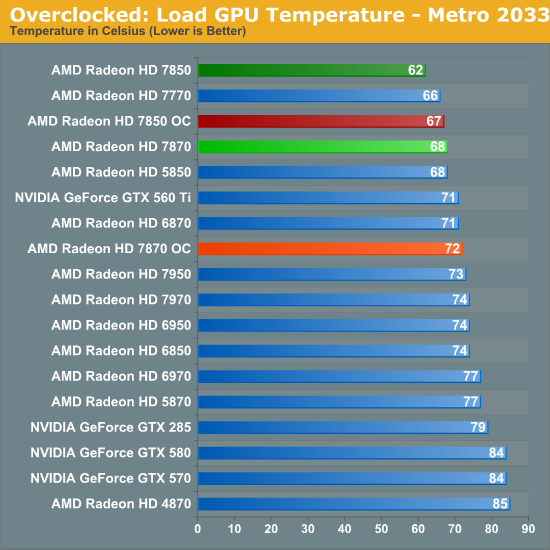
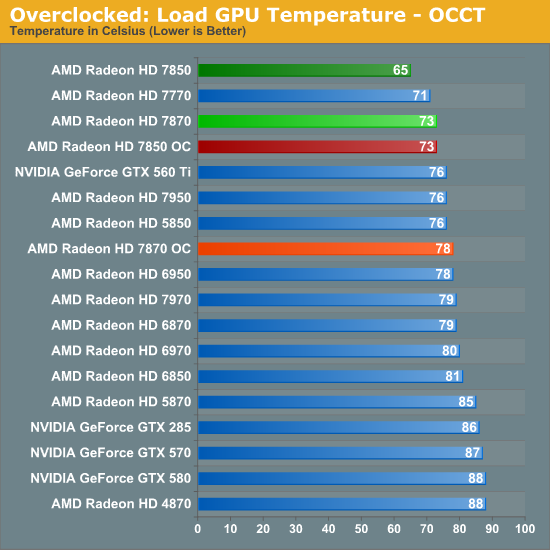
Of course when power consumption goes up so does temperature. For both cards under Metro and for the 7870 under OCCT this amounts to a 5C increase, while the 7850 rises 8C under Metro. However as with our regular temperature readings we would not suggest putting too much consideration into the 7950 numbers since it’s using a non-retail design.
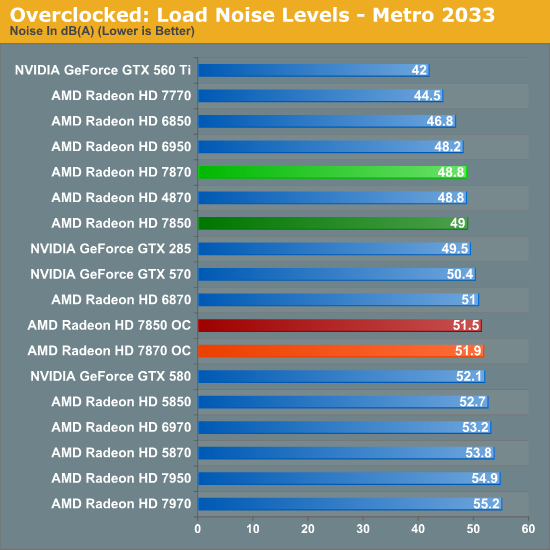
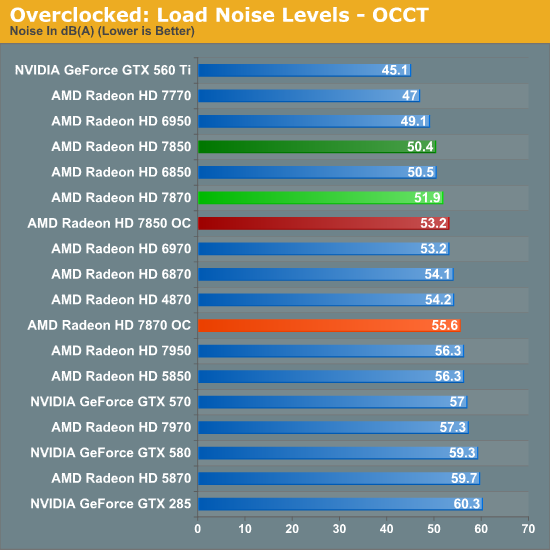
AMD’s conservative fan profiles mean that what are already somewhat loud cards get a bit louder, but in spite of what the earlier power draw differences would imply the increase in noise is rather limited. Paying particular attention to Metro 2033 here, the 7870 is just shy of 3dB louder at 51.9dB, while the 7850 increases by 2.7dB to 51.5dB. OCCT does end up being worse at 2.8dB and 3.7dB louder respectively, but keep in mind this is our pathological case with a much higher PowerTune limit.










173 Comments
View All Comments
arjuna1 - Monday, March 5, 2012 - link
Metro 2033 (the highest settings bench)Radeon 7950 33fps
Radeon 6970 27.5fps
Radeon 6870 32fps (the second highest bench)
Weee!!! $400+ for 5.5fps more.
Not sure about you, but to me, spending that kind of cash for an imperceptible increase in performance is having no sense of money's worth.
This generation of cards can safely be skipped until the 8xxx/7xx series from both AMD and NVIDIA.
Death666Angel - Tuesday, March 6, 2012 - link
Picking up one specific benchmark to underline your point. Great reasoning skills, you should join a debate team! Also, that 5.5fps is still 20%, with the good track record of overclockability, it can reach as much as 40%. But you stick to your point.arjuna1 - Tuesday, March 6, 2012 - link
What? were you expecting me to post a powerpoint presentation for just for you??The numbers are there, look at them if you want, but hey, be stuck in your point, only a frustrated basement geek can think in way to justify spending $400 +/- for less than 50% increase in performance.
Be careful of not falling of that horse, seems pretty high.
sseemaku - Tuesday, March 6, 2012 - link
Please check the avg frame rate improvements, not some specific results. But everyone agrees that 7xxx cards are a bit overpriced and that's because they don't have competition right now. If you worry about power consumption, buy these cards now. Or more interested in price/performance, wait till Kepler is released.arjuna1 - Tuesday, March 6, 2012 - link
I can agree with that, after Kepler is release prices will go down and maybe then the 7xxx series will increase in the perceived value.CeriseCogburn - Thursday, March 8, 2012 - link
If there's no competition then they aren't overpriced because they cannot be touched by anything, hence making their price absolutely correct !!!I call that "reality".
If Kepler blows their doors off, their price will fall. That's reality too.
It's time for all the amd is cheaper crud to go the way of the dinosaur.
Recently a 460 was an unbeatable value. Then a 560ti was as unbeatable value. Currently a 6870 is an unbeatable value.
These things happen, and a deal is not the general aspect of the video card prices, which generally speaking wind up right where they should be.
The deal is the exception to the usual rule across the board, and "the deal" as in "big price drop" is usually just one card here or there for a short period of time.
CeriseCogburn - Thursday, March 8, 2012 - link
Radeon cards have been coming out at $700 and $600 and $500+ for a long time man - even with competition.I don't know what planet you people come from when the constant repetition of "it sounds good" becomes an absolute meme and ongoing restated theme but in no way reflects even a tiny kernel of truth as far as reality goes.
CeriseCogburn - Friday, March 9, 2012 - link
Yes dagamer34, Ryan praises amd for drying up their 6000 series channel with such precision. Then we get this praise - the perfect price structure by AMD, and "it's conservative pricing" according to the author even though it's $40 and $30 higher than it's Nvidia counterpart..." With AMD targeting the ~$320 570 and ~$210 560 Ti and given their conservative pricing on the rest of Southern Islands, it should come as no surprise that the 7800 series is priced equally conservatively. The 7870 will have an MSRP of $350, while the 7850 will have an MSRP of $250. With the 7800 series completing the launch of Southern Islands, this gives AMD a consistent price structure for the entire family: $550, $450, $350, $250, $159, and $109."
---
I see. So more expensive is conservative, and the 6 AMD price figures are perfect and consistent...
I am so sick of it...
Falkenad2 - Monday, March 5, 2012 - link
Thus far, AMD's first foray into 28nm graphics has been unimpressive. From a price/performance standpoint, the 7000 series has not given the usual incentives for upgrading that is regularly associated with the move to a new node. I hope a strong competitor from nVidia is on the way, as that would bode well for consumers such as ourselves. As it stands, the 7000 series lacks value except at the very high end, where price/performance is of little concern.Kaboose - Monday, March 5, 2012 - link
Price vs. performance is not the only factor, some people are concerned with power draw as well. Others are interested in temps, and noise. The price could use some work (come on Nvidia) but besides that the 7xxx series has been fairly impressive in regards to overclocking, power, temp, and noise.